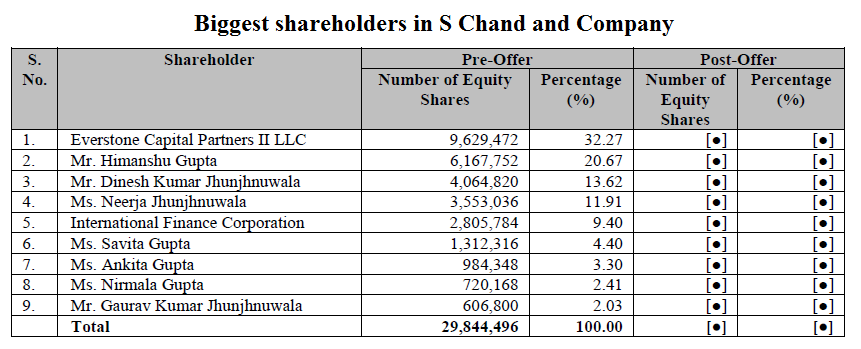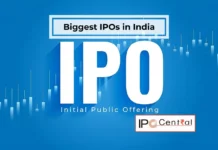
When S Chand IPO opens next week, it will be the first mainboard IPO this month. While Shankara Building Products had a strong listing, CL Educate disappointed investors with its tepid listing. The stock has since gained but still continues to trade below its IPO allotment price of INR502 per share. This makes investors a little jittery about S Chand since it is in publication business. Technically, coaching and publishing are as similar as chalk and cheese but it is the sentiment which matters!!! We will see more in this S Chand IPO Review.
The textbook publisher has priced its IPO in the range of INR660 – 670 per share. Investors will have time between 26 and 28 April to subscribe to the offer and the book for anchor investors will open on 25 April. Investors can place bids for 22 shares and in multiples thereafter. The company has increased its fresh issue size to INR325 crore from the earlier INR300 crore. In addition, there will be an offer for sale (OFS) of 6,023,236 shares which is valued at INR403.5 crore on the upper end of the price band. The IPO will be managed by JM Financial, Axis Capital, Credit Suisse Securities while Link Intime has been appointed the registrar. Through S Chand IPO review, we try to find out if it makes sense for investors to put money in this offer.
S Chand IPO details
| Subscription Dates | 26 – 28 April |
| Price Band | INR660 – 670 per share |
| Fresh issue | INR325 crore |
| Offer For Sale | 6,023,236 shares (INR403.5 crore) |
| Total IPO size | INR728.5 crore (at upper price band) |
| Minimum bid (lot size) | 22 shares |
| Face Value | INR5 per share |
| Retail Allocation | 35% |
| Listing On | NSE, BSE |
S Chand IPO Review: Fresh + OFS, no surprises
As mentioned above, S Chand has increased the amount it aims to raise by issuing new shares to INR325 crore. This money will be used towards repayment and prepayments of loans taken by S Chand and its subsidiaries. These loans also include debt it undertook to acquire Kolkata-based publisher Chhaya Prakashani. Debt repayment is always good and it is no different for S Chand which had a debt equity ratio of 0.34 as of 31 March 2016 and 0.82 as of 31 December 2016. The higher figure for the latest period reflects the cyclicality of the business (being an educational publishing house, it registers as much as 75% of its revenues in the last fiscal quarter). However, the benefits of interest payment reduction will be offset by equity dilution.
Read Also: Upcoming IPOs in 2017 to keep an eye on
Like most other public offers, S Chand IPO will also have an OFS component of 6,023,236 shares which will be led by private equity (PE) investor Everstone Capital. The PE firm plans to sell 4,814,736 shares or half of its shareholding in the company while smaller number of shares will be offered by Himanshu Gupta, Dinesh Kumar Jhunjhnuwala, Neerja Jhunjhnuwala, Nirmala Gupta, Savita Gupta, Ankita Gupta and Gaurav Kumar Jhunjhnuwala.
Everstone made its first investment in S Chand in 2012 and also participated in subsequent rounds of funding. S Chand counts World Bank’s International Finance Corporation (IFC) as another prominent investor. IFC has a 9.4% equity stake through its investment in November 2015 but will not participate in the OFS.

S Chand IPO Review: Publishing is mundane but S Chand shines
Publishing is not the sector one would typically associate with scalable business models. It is scalable in terms of decades but may also appear an alien concept when seen through the lens of venture capital firms where businesses are built, ramped-up, and marked-down overnight, relatively speaking. On the contrary, it is a business where scaling-up effectively translates into striking a delicate balance. Especially in K-12 segment, the seasonality is quite high as purchases are mostly made in Jan-Mar quarter. This massive seasonality throws its own set of challenges such as scarce printing, warehousing and raw material resources during this period. Coming back to S Chand, the company has handled these challenges quite successfully and clearly there are some initiatives which deserve a closer attention.
Read Also: Here is why you should consider opening a Free Demat Account
One of these is the commendable backward integration S Chand has achieved. The company has invested INR45.3 crore in its printing facility in Sahibabad in the last couple of years which has greatly reduced its dependence on third-party vendors. According to S Chand’s red herring prospectus, 85% of its printing requirements in FY2016 were met by facilities in Sahibabad and Rudrapur. The two printing facilities have a capacity to print up to 64.24 million pages per day.
A robust distribution and sales network is a prerequisite for a business like publishing and S Chand has a vast network to boast of. This network involves 4,932 distributors and dealers of its own and another 771 from Chhaya as of 31 December 2016. In addition, the company has an in-house team of 838 sales personnel working from 52 branches and marketing offices across India. Similarly, S Chand’s network comprises of 42 warehouses located in 19 states to allow coverage across India. It also has gained access to two warehouses in West Bengal and one in Tripura as a result of acquiring Chhaya Prakashani.
S Chand IPO review: Financial performance
As mentioned in this earlier piece, S Chand has been consistent with revenue growth and has managed to expand its top line at an average rate of 32.6% in the last four years. From just INR174.6 crore in FY2012 to INR540.6 crore in FY2016 – clearly, this is impressive. This growth is not all organic (not that we have any issues with that) as the investment from private equity firms has been put to use in acquiring smaller competitors. Chhaya Prakashani in 2016, New Saraswati House in 2014, and Vikas Publishing House (including Madhubun brand) in 2012 are some recent acquisitions. In total, the company operates 12 subsidiaries, mostly through various acquisitions.
S Chand’s consolidated financial performance (in INR crore)
| FY2012 | FY2013 | FY2014 | FY2015 | FY2016 | 9M FY2017 | |
| Total revenue | 174.6 | 281.5 | 370.9 | 478.5 | 540.6 | 150.8 |
| Total expenses | 147.5 | 221.7 | 291.2 | 374.5 | 412.4 | 234.3 |
| Profit after tax | 14.7 | 32.0 | 42.6 | 32.8 | 46.6 | -88.5 |
| Profit margin (%) | 8.4 | 11.4 | 11.5 | 6.9 | 8.6 | -58.7 |
Source: S Chand’s red herring prospectus
While revenue growth has been impressive, the company’s performance in terms of earnings is not that consistent. Nevertheless, profits have grown from INR14.7 crore in FY2012 to INR46.6 crore in FY2016. Except a decline in FY2015, profits have growth every year. Margins have remained in the range of 6.9% to 11.5% in the recent years, though it ended FY2016 with net margin of 8.6%.
Thanks to the red herring prospectus, we have details of financial performance in the latest period of nine months ended 31 December 2016. And it is not very impressive as revenues are just INR150.8 crore and the company is in loss of INR88.5 crore. S Chand claims that due to high seasonality, as much as 75% of its sales happen in the last quarter of the FY. Since we have no way of corroborating this, we take these figures on face value.
S Chand IPO review: Should you invest?
Since the company’s business model is well-established, valuations take center stage in S Chand IPO review. Also, it is not the first of its kind business to list on Indian exchanges which means, there is no case of premium valuations. Although Navneet Education gets slightly above 45% of its revenues from stationary, publishing is simply the largest business line. For S Chand, Earnings Per Share (EPS) of INR17.09 means the IPO is priced at a P/E multiple of 39.2. Going by the past growth rates, the company may post higher profits for FY2017 but in absence of full year data, we would restrict ourselves to FY2016. We find this ratio quite high even for a fast growing business. In comparison, Navneet is available at a P/E ratio of 31.6 which is not cheap by any stretch but looks better than S Chand. Unlike S Chand, Navneet isn’t a pure publishing play but it still serves the purpose of putting things in perspective. We also find Navneet a better play as it had higher net profit margin of 13.7% in FY2016 and is pretty much debt-free in terms of long term loans. Navneet also has a higher Return on Net Worth (RONW) of 20.3% in FY2016 as compared to S Chand’s 7.8%.
For sure, S Chand is an old and well-established brand but it doesn’t appear that end users have much brand preference of their own. Mostly, students and their parents go by what the school decides. With little loyalty in the K-12 textbook business, the associated lines of competitive exams and early learning are getting strong competition from online and digital channels. S Chand is expanding its footprint in these areas as well but as it happens with new lines, past performance is no guarantee of future.
Another important aspect we found in S Chand IPO review is that it sold shares to IFC at the rate of INR392 apiece. Although IFC is not participating in the IPO, we find it difficult to understand how this IPO has been priced at nearly 71% mark-up over the last transaction in a gap of just 17 months. Everstone’s average cost of acquisition is lower at INR270 per share for investment which was spread over several years starting from 2012. As such, IFC paid a premium of just 45% over Everstone’s cost but IPO investors are being asked to shell out a premium of 71%. Beats us totally and actually reminds of ICICI Prudential Life Insurance IPO which remained below its allotment price for long after listing.
In conclusion of S Chand IPO review, we feel the IPO is priced quite high and leaves little on the table for IPO investors. Given the current state of Indian markets, the IPO is likely to sail through easily. However, any shock coming from French elections or elsewhere can now cause a selloff and investors can get trapped in that event.







































You can tell me yeh kitne me sale hoo rha h I was conferm please
555 me
sir 8 application he schand ki if you want to buy please whatsapp me on 9276203330
So the co conclusion is to stay away from this ipo.. Could you please suggest any good one?
its a superhit ipo